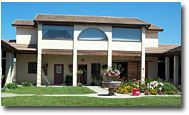
|
|
Vol. 10 No.4 - May '02
Central Coast - Paso Robles |
|
|
Vineyards
& Wineries Visited -
|
|
|
Clos
Pepe |
|
|
|
Journal and tasting notes from visits to several California wineries and vineyards. Our destination was Paso Robles to attend the annual Hospice du Rhone, (Friday and Saturday May 31 and June 1st), and we decided to make a few stops both beforehand and during the event days.
Tasting Notes / Scores: Brief tasting impressions are included in the winery write-up. The alpha scores are expressed in Aroma/Taste format, and may be compared to numerical scores by referencing the conversion chart. An "n/n" indicates that no notes were taken.
Barrel Tasting: a few words about barrel sampling are probably in order. Although this is one of the most enjoyable and enlightening of tasting processes, it is also one that causes more than a little angst among winemakers. The simple fact is that the wine you are sampling hasn't finished developing as yet - it's still going through growth and maturation in the barrel, and is a work in progress. Therefore, winemakers are often reluctant to show off their creations - concerned the wines may be misunderstood or unappreciated by the taster. The tasting notes in this report are mostly of barrel samples. And, my impressions are just that - my impressions of the wine at its current stage of development.
Wednesday, May 29, 2002
Leaving SoCal about 7:00am, our first stop was Clos Pepe Vineyards, in Santa Barbara County. From there, we'd planned to head on up to Paso and Mat Garretson's open house at Garretson Wine Company. In addition to Garretson's wines, two other operations that make wine at Mat's place were due to be pouring as well - Saxum, Justin Smith's new label, and Ken Winchester, who recently released his first Winchester Vnyds wines: a Syrah and a Rhone blend. And as an extra bonus, it turned out that Cris Cherry was pouring new wines under his Villa Creek restaurant label as well. Then finally, to finish the day, the WCWN offline was scheduled for 6:00 in the evening. Seemed like a big day.
|
Selected Tasting Notes: ...from barrel... 2001 Clos Pepe Chardonnay - (stainless steel). Slightly funky nose of lees and swamp water. Nice undercurrent of pure crisp fruit. Nice balance, very crisp mouthfeel, lots of solid fruit through long finish. Aroma/Taste: B+/B+ 2001 Clos Pepe Chardonnay - (Latour barrel). Lemon-scented nose, with a touch of toast and roasted grains. Very nice mouthfeel, excellent balance, mostly lemon and lime fruit, with a toasty long finish. Aroma/Taste: B+/B+ 2001 Clos Pepe Pinot Noir - (115 clone). Nose of bing and black cherry, with nice spicy aroma. Full mouthfeel, almost crisp cherry and strawberry fruit, nutmeg and clove spices, and a lightly toasty long finish. Aroma/Taste: B+/B+ 2001 Clos Pepe Pinot Noir - (stainless steel). Interesting, almost stark nose of pure cherry fruit - similar to smell of processing grapes for jelly. Primal fruit, with a light spicy grapeskin quality, and somewhat bitter long finish. Aroma/Taste: B/B 2001 Clos Pepe Pinot Noir - (Vigneron Select). Fabulous nose of spiced cherry and cola, with lots of sauvage and a forest floor background note. Full, rich mouthfeel, excellent balance, lots of dense cherry fruit, and very long finish. Aroma/Taste: A-/B+ 2001 Clos Pepe Pinot Noir - (new oak). Fully oaked nose of black cherry with light touch of spice and licorice. Big chewy mouthfeel, concentrated oaky and slightly bitter fruit, with a very long somewat tannic finish. Aroma/Taste: B+/B+ 2002 Clos Pepe Botrytus Chardonnay - (stainless steel) $28. Cloudy swampwater appearance, with a nice apricot and pear aroma. Very fruity mouthfeel and sweet taste, with fabulous balance and long finish. Aroma/Taste: B+/B+ 2002 Clos Pepe Botrytus Chardonnay - (Croatian oak) $28. Cloudy swampwater appearance, with a toasty and spicy pear and nectarine aroma. Full mouthfeel, sweet and lightly toasty fruit, with excellent balance and long finish. Aroma/Taste: B+/B+ |
Arriving at Clos Pepe about 10:00, we met up with vineyard manager and winemaker Wes Hagen and his wife Chanda. Thanks to Tom Hill, a visit had been arranged with Wes to show us the Clos Pepe vineyard, as well as barrel taste through a few of his new wines. Along for the tour was Tom, Larry Archibald, Brian Loring, Bob Summers, and Mike Mooney.
Located just West of the Babcock and Melville wineries on Hwy 246, Clos Pepe is situated smack in the middle of what will be the new Santa Rita Hills appellation ... well, maybe. These wineries, along with Sanford, Lafond and Longoria applied for AVA status through the usual channels. However, as It turns out, the Chilean winery, Santa Rita, has taken some exception to the chosen name. This all seems more than a little ironic, considering this particular Santa Barbara County appellation would probably serve to enhance the Chilean winery's name, rather than detract from it. A deal is supposed to be eventually struck that would allow the AVA name on the label, along with a slight caveat.
Like most Santa Barbara County wineries, Clos Pepe is a family operation. The former 40-acre horse ranch was purchased several years ago by Cathy and Steve Pepe, Wes' mother and stepfather. Before setting up the 28-acre vineyard, the family consulted with Jeff Newton and Larry Finkle of Coastal Vineyard Care to site and plant the vineyards. Burgundian varietals are Wes' passion, and that's all that's grown here - with Pinot Noir claiming the vast majority of acreage.
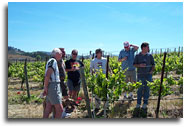 After
trying a few wines in the cellar/lab, Wes took us for a stroll into the
vineyard. Wes pointed out that this area is ideal for growing Pinot and
Chardonnay, as it is subjected to morning fog and cool windy afternoons.
In fact, nearly everything between the Santa Ynez Valley and Lompoc, is
exceptionally cool - some 15-20 degrees cooler than most areas barely
10 miles away to the East. As the conversation turned to all the various
clones of Pinot, Wes stated his own preference leans to the 115 clone.
After
trying a few wines in the cellar/lab, Wes took us for a stroll into the
vineyard. Wes pointed out that this area is ideal for growing Pinot and
Chardonnay, as it is subjected to morning fog and cool windy afternoons.
In fact, nearly everything between the Santa Ynez Valley and Lompoc, is
exceptionally cool - some 15-20 degrees cooler than most areas barely
10 miles away to the East. As the conversation turned to all the various
clones of Pinot, Wes stated his own preference leans to the 115 clone.
Although
Clos Pepe sells about 90% of its fruit to the likes of Siduri, Ojai, Babcock,
Loring, Clifton-Brewer and Hitching Post, they keep roughly 3.5 acres
(about 250 cases) of Pinot Noir to bottle 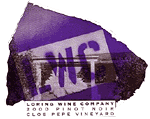 under
their own label. Commenting on the current upswing of wineries producing
vineyard-specific bottlings, Wes seemed very passionate about his desire
to have those who purchase his fruit, also produce it as a Clos Pepe vineyard-designate
bottling. The point is obviously not lost on his clients, either. Wes
related a story of how Brian Babcock couldn't guarantee that the Clos
Pepe fruit he'd contracted for would become a vineyard designate bottling,
but rather might end up in a Santa Barbara County blend. Since Babcock
felt he'd rather stick with the blending concept, he offered to tear up
his contract with Clos Pepe, offering the fruit back to Wes. Wes was initially
surprised by the his gesture. But with buyers practically waiting in line
for his fruit, it didn't present any problems for him.
under
their own label. Commenting on the current upswing of wineries producing
vineyard-specific bottlings, Wes seemed very passionate about his desire
to have those who purchase his fruit, also produce it as a Clos Pepe vineyard-designate
bottling. The point is obviously not lost on his clients, either. Wes
related a story of how Brian Babcock couldn't guarantee that the Clos
Pepe fruit he'd contracted for would become a vineyard designate bottling,
but rather might end up in a Santa Barbara County blend. Since Babcock
felt he'd rather stick with the blending concept, he offered to tear up
his contract with Clos Pepe, offering the fruit back to Wes. Wes was initially
surprised by the his gesture. But with buyers practically waiting in line
for his fruit, it didn't present any problems for him.
Wes had us carpool over to Buellton to the crush facility where he makes his wine. Grabbing a thief, Wes set about providing us with samples of a few more things, including a 2002 Botrytis Chardonnay - picked in January! Wes and Chanda were gracious hosts, and we had a great time.
|
Selected Tasting Notes: ...from bottle... 2000 Saxum - James Berry Vnyd. Dense, yet bright nose of blackberry, licorice, tar and shoe polish. Big and chewy in mouthfeel, with lots of licorice-infused fruit, and a very long fabulously sweet finish. Aroma/Taste: A-/A- 2000 Winchester Cuvee Voisins - Paso Robles. Seductive aromas of dark fruit, tarry notes, with slight stewy notes and hit of bacon. Very fleshy and meaty on the palate, the mid-section of this wine is terrific, and the fruit lasts through the finish and beyond. Structured very nicely, this GSM blend has a future. Aroma/Taste: A-/A- 2000 Winchester Syrah - Paso Robles. Dark fruits, tar, bittersweet chocolate and a hint of shoe polish in the nose. Rich and smooth, the licorice seems to dominate the blackberry fruit at the front-end, with Black Jack gum flavors picking up at mid and latter palate, and through long very smooth finish. Aroma/Taste: A-/A- ...from barrel... 2001 Garretson Grenache - Rozet Vnyd, Paso Robles. Sweet raspberry and strawberry nose. Dense and extracted, excellent ripeness and balance, with a long seamless finish. Aroma/Taste: B+/A- 2001 Garretson Syrah - Vogelzang Vnyd, Santa Ynez Valley. Beautiful nose of inky blackberry, raspberry and licorice. Tasty and chewy mouthfeel, with a excellent fruit and a long finish. Aroma/Taste: A-/B+ 2001 Garretson Syrah - Winchester Vnyd, Paso Robles. Slightly reduced and rubbery aromas compliment the blackberry fruit. Lots of blueberry and blackberry fruit, with a meaty mouthfeel, and fabulous long finish. Aroma/Taste: B+/A- 2001 Garretson Syrah - Bassetti Vnyd, Paso Robles. Mouthwatering nose of blackberry, blueberry and white pepper. Full mouthfeel , balanced acids, and long finish. Aroma/Taste: A-/A- 2001 Saxum Syrah - James Berry Vnyd. Stunningly beautiful nose of black jam, with blueberry and mocha, mingled with licorice, tar, and redwax lips! Rich and full on the palate, with lots of chewy dark fruit, tarry notes, and long finish. Aroma/Taste: A/A- 2001 Saxum Syrah-Mourvedre - James Berry Vnyd. Rich nose of black jam and smoked meat, with a touch of raspberry and licorice. Chewy mouthfeel, with lots of dark fruit, charry notes, and long finish. 2/3 Syrah. Aroma/Taste: A-/A- 2001 Lucky at Cards - James Berry Vnyd. Fabulous nose of toast, blackberry, licorice, tar, and grilled meat. Rich and full mouthfeel, with lots of chewy fruit, toasty notes, and a long smooth finish. Blend of Mourvedre-Syrah-Grenache. Aroma/Taste: A/A- 2001 Saxum Zinfandel - Cherry Vnyd. Stunningly beautiful nose of black jam, with blueberry and mocha, mingled with licorice, tar, and redwax lips! Rich and full on the palate, with lots of chewy dark fruit, tarry notes, and long finish. Aroma/Taste: A/A- ...from bottle... 2001 Villa Creek Grenache-Mourvedre - Glenrose Vnyd. Almost a Cote Rotie-like smoky nose. Delicious taste and mouthfeel, with excellent balance and long finish. Aroma/Taste: B+/A- 2001 Villa Creek Syrah - Dollarhide Vnyd. Rich, jammy blackberry nose. Smooth, succulent and elegant mouthfeel, with ample fruit and long finish. Aroma/Taste: B+/A- 2001 Villa Creek Syrah - Locke Vnyd. Dense tarry blackberry nose. Sweet mouthfeel, lots of licorice-infused fruit and long finish. Aroma/Taste: A/A- |
Arrived at Garretson Wine Company off Hwy 46 East about 1:30. Mat and Amie had decided to hold an Open House to celebrate what has basically become Hospice du Rhone week. By the time we arrived, everything seemed to be in full swing. Amie Garretson, Justin Smith (Saxum), Ken Winchester (Winchester Vnyds), and Cris Cherry (Villa Creek) were pouring their wines to a dozen or so folks all milling around the tasting bar. After we'd tried a few of the bottled wines, Mat hollered, "Okay, let's all go do some barrel tasting." With no one willing to disagree, we headed into the GWC backroom to tap a few barrels.
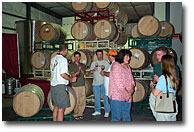 |
| l to r: Chris Cherry, Justin Smith, Brad Harrington, Augie Hug, Raquel and some other folks all enjoying the open house |
With lots of barrels to choose from, Mat selected a few "choice" items and each of us stepped on up to the wine thief. We were able to taste through several wines each from Garretson and Saxum, along with an HdR auction special GSM blend, Lucky at Cards. Then, we headed back out to the front room for another go-around at the bottled wines, including Cris Cherry's future lineup. In fact, the VC wines were some surprisingly excellent stuff, from some little known (to me) vineyards.
The open house finally broke up about 4pm or so and we drove back into town to claim our motel reservations and freshen up a bit, before heading over to Villa Creek and the WCWN offline. (The annual WCWN event has previously been held following the HdR Friday night winemaker dinners. Most of the "on-liners" usually wanted to get together, but after a full day of wine, followed by an evening wine dinner..., well having a wine off-line afterward was like bringing sand to the beach. So, with Thursday already staked out as HdR's Bowling night, Brad Harrington decided to hold the WCWN offline as a dinner event at Villa Creek on Wednesday evening.) Had a great time at the offline, meeting Charlie Chadwick, Brad Ballinger, Bob Davis, Mitch Tallan and many others.
Thursday, May 30, 2002
With no HdR festivities scheduled until the Rhone N'Bowl at 7:00pm (yep - bowling), we had the entire day to ply our way around the Westside of Paso in search of good wine (oh, it's not a job - it's an adventure!). We had an invitation to visit Tablas Creek for a nursery/vineyard tour and tasting at 4:00, so we were making on our own schedule until then.
|
Selected Tasting Notes: NV Pesenti Red Velvet Zinfandel - Paso Robles. Very ripe nose with a hint of ethanol and kitchen nose. Soft mouthfeel, with moderate cherry flavors and slightly hot finish. Aroma/Taste: B-/B- 1999 Pesenti Cabernet Sauvignon - Paso Robles. Smells hot and ripe. Decent mouthfeel, but tastes a bit austere, with high acids leading to a sharp finish. Aroma/Taste: B-/B- 1998 Pesenti Zinfandel - Paso Robles. Moderate Zinny nose and flavors. Seems a little light in body, with medium-long finish. Aroma/Taste: B/B- 1999 Pesenti Zinfandel - Paso Robles. Nice blackberry and raspberry aromas. Fruity mouthfeel, some tarry notes, with nice, if acid-balanced, finish. Aroma/Taste: B/B |
Arrived at Turley and joined the throng - mostly HdR'ers like Bob Davis and Charlie Chadwick tuning up for the afternoon's tasting. With the winery's name now officially changed from Pesenti Winery to Turley Wine Cellars, we were hoping that there might be a little Turley thrown into the regular tasting. But, no such luck. They did however have a flight of 4 Turleys available for a tasting fee.
Some of the original speculation had Turley incorporating a few of the revamped Pesenti Vineyards into a single vineyard Turley bottling. This hasn't happened... as yet. And, while it may still come to pass, Turley seems content to just continue using the Pesenti label for these wines - at least for the time being.
|
Selected Tasting Notes: 2001 Pipestone Viognier - Paso Robles. Crisp, with a tropical-apricot quality. Aroma/Taste: B/B 2001 Pipestone Grenache Rose - Paso Robles. Nose and flavors of strawberry tea; tasty finish. 15% alcohol. Aroma/Taste: B/B+ 2000 Pipestone Melange - Paso Robles. Dry, toasty mouthfeel, with a nice fleshy/stemmy quality, and tasty long finish. Aroma/Taste: B+/B+ 1999 Pipestone Syrah - Paso Robles. Beautiful nose; slightly austere mouthfeel. Aroma/Taste: B+/B 2000 Pipestone Zinfandel - Paso Robles. Nose of boysenberry, pepper and spice. 50/50 Sauret and Jacobson Vnyd (Dos Robles). Aroma/Taste: B+/B 2000 Pipestone Vin Rouge Mediterranen - Paso Robles. Nice meaty nose and flavor, very good balance and long finish. Aroma/Taste: B+/B+ |
Arrived at Pipestone Vineyards at about 11:00. Jeff Pipes and his wife Florence run this small, relatively new, winery on Niderer Rd. When they decided to plant Rhone varietals, they were bucking the conventional wisdom in Paso to plant Zinfandel. But, their gamble seems to be paying off, given that many others were doing the same thing at nearly the same time.
We arrived to a much busier place than our visit last year. Jeff appears to now be "on the map," especially obvious to us since a reporter arrived, stealing him away to discuss his operation. Meanwhile, we talked with Florence for awhile, while tasting through the current Pipestone offerings. Ironically, Pipestone is now also making a Zinfandel from purchased grapes. Although they didn't make one the first year, I'm sure this is one of those situations where a local Paso winery needs to have what people want or expect to find, and Pipestone is no exception.
The GSM-blended Melange continues to be a solid part of the lineup, and Jeff has now added another blend with the Vin Rouge. Pipestone is up to 1600 cases for the 2000 vintage.
|
Selected Tasting Notes: 2000 Grey Wolf Zinful Cab - Paso Robles. $12. Nose boysenberry and toasty oak. Nice, if light mouthfeel. good balance and finish. 50% zin, 39% cab, 20% syrah. Aroma/Taste: B/B 1999 Grey Wolf Merlot - Paso Robles. $18. Fleshy cherry and vanilla nose, nice oak treatment, with a good grip on the medium-long finish. 20% Cabernet. Aroma/Taste: B+/B 2000 Grey Wolf Syrah - Paso Robles. $20. Austere, green bean-scented blackberry nose. Lightly chalky mouthfeel, good flavors with a soft finish. Aroma/Taste: B/B 2000 Grey Wolf Zinfandel - Paso Robles. $18. Nose of boysenberry and raspberry. Full mouthfeel, with plenty of fruit and nice balanced finish. Aroma/Taste: B+/B+ 1999 Grey Wolf Reserve Merlot - Paso Robles. $23. Dense and fleshy nose, full mouthfee, nice flavorful long finish. Aroma/Taste: B+/B+ 1999 Grey Wolf Meritage - Paso Robles. $28. Very fleshy and fruit-driven nose. Good concentration on palate, nice balance, some vegetal notes on otherwise long finish. 60% cab, 25% merlot, 15% cab franc. Aroma/Taste: B+/B+ 1999 Grey Wolf Alpha Cabernet - Paso Robles. $24. Nose of ripe fleshy cassis and toasted grains. A bit tart on the palate, with good balance, and long finish. Aroma/Taste: B+/B |
Arrived about 2:00 at Grey Wolf. Hadn't been here in a couple of years, but remembered that Grey Wolf seemed to concentrate more on the Cab and Merlot-based wines (again, in contrast to most of Paso's wineries). This time out, they had a Syrah as well. We decided to try just the reds from their extensive list.
Grey Wolf's tasting room is actually in the livingroom of an old house, just up a little driveway off Hwy 46 West. With 11 acres of estate vineyards, Grey Wolf does produce some Estate wines. However, most of the wines come from purchased fruit.
Always very friendly to visitors, they seem to treat everyone as though they're a local resident, and you get the immediate sense that this is a family business. Currently producing about 3,000 cases, Grey Wolf is continues to fill a niche in non-Zin Paso Robles.
|
Selected Tasting Notes: 2000 Adelaida Chardonnay - San Luis Obispo. $18. Nose of creamy lemon and lime, with a nice smoky note. Almost buttery in mouthfeel, with spice and tropical flavors. Aroma/Taste: B+/B+ 1999 Adelaida Pinot Noir - HMR Estate, Paso Robles. $32. Nose of black cherry and spice, with a light cola and toast quality. Slightly stemmy fruit, obvious oak, very tasty, and nice long finish. Aroma/Taste: B+/B+ 1999 Adelaida Pinot Noir Reserve - HMR Estate, Paso Robles. Big rich stemmy and smoky nose. Lots of chew in this huge mouthful of off-sweet black cherry fruit. Aroma/Taste: A-/B+ 1999 Adelaida Syrah - Viking Vnyd, Paso Robles. Big, beautiful inky and tarry nose. Lots of blackberry and blueberry fruit on the palate, good balance, but the fruit comes up a bit tart and short on the finish. Aroma/Taste: B+/B 1999 Adelaida Meritage - Paso Robles. Lots of stemmy and mineral qualities in the nose, with just a tinge of green quality along with obvious new oak. Slightly soft tannins, semi-sweet fruit and long finish. 45% CF, 35% Merlot. Aroma/Taste: B/B+ 1998 Adelaida Cabernet - Paso Robles. Nice black cherry/cassis nose, with just a touch of spice and vanilla. Medium-light mouthfeel, good balance and flavors, long finish. Aroma/Taste: B/B NV Adelaida School House Zinfandel - Paso Robles. More of a quaffer, with its fruity nose and correct flavors, just a bit light on the palate, medium-long finish. Blend of the '99 and '00 vintages. Aroma/Taste: B/B 2000 Adelaida Zinfandel - Paso Robles. Lots of boysenberry in the nose and mouthfeel. Lovely aroma hangs in glass long after wine is gone. Blend of 3 Westside vnyds. Aroma/Taste: B+/B+ 1999 Adelaida Cabernet Reserve - Viking Vnyd, Paso Robles. Big and gutsy, with a slight acid bent that leads to a long, long, if slightly tart finish. Aroma/Taste: B+/B+ |
We decided to make Adelaida our last stop, before the scheduled Tablas Creek appointment. We figured to have about an half-hour to sample a few of the Adelaida wares - probably more than enough time. The tasting room was a little busier than as usual, with the HdR event probably bringing more people to Paso for the weekend. In fact, there were a few locals from the HdR staff in the room.
The last couple of visits here were mixed - sometimes we found some interesting wines, sometimes not. And, since we were just dropping by without an appointment, our expectations weren't grandiose. But...surprise! After noticing that we seemed serious about wine, Adelaida sales manager Paul Sowerby took us in tow, leading us through the current lineup, while giving us a little background on both the Viking and HMR vineyards. The HMR Estate (Hoffman Mountain Ranch) was originally planted in the '70s, but eventually fell into a state of neglect, and was sold. The label actually disappeared from the marketplace for over a decade, finally resurfacing as Hidden Mountain Ranch in the mid-'90s. Meanwhile, Adelaida had purchased the Pinot Noir vineyards in the early '80s--- but didn't buy the rights to the label itself. The Viking Vnyd consists of 20 acres on Peachy Cyn Rd, planted to 3/4 Syrah in '91. The first vintage was 1995.
Good visit. In fact, it was so good, we overstayed our expected time and were now running late for our next stop. Thanks to Paul, a fitting end to our day of touring.
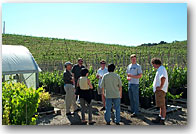 |
Arrived
about 4:30. It had been awhile since I last visited Tablas Creek (1st
visit- 3/'00), so I was curious to see what changes might have taken
place. A small tour & tasting had been arranged to showcase the vineyard
& winemaking facility, as well as their burgeoning nursery business.
(Tablas Creek propagates rootstocks supplied to them originally by Ch.
Beaucastel.) Their full nursery produces French (Tablas) clones of Mourvédre,
Grenache Noir, Syrah, Counoise, Roussanne, Viognier, Marsanne, and Grenache
Blanc. The recent addition of some Pinot Noir mother vines to the nursery
might bring an interesting element to future domestic Pinot. Thus far,
Tablas clone vines have been sold to the likes of: Ridge, Qupé,
Bonny Doon, Beckmen, Andrew Murray, Cedarville, Zaca Mesa, L'Aventure,
Garretson, and Justin, as well as a few out-of-state producers.
Early On
|
Selected Tasting Notes: 2000 Tablas Creek Anthesis - Lots of pineapple and light spice in the nose. Crisp, lighter mouthfeel, just a touch of something medicinal. Not at all cloying or sweet-tasting. Made from using indigenous yeast on Dijon clone Chardonnay from Sonoma County. Aroma/Taste: B+/B 2000 Tablas Creek Clos Blanc - Nose of tropical fruit and lightly toasted grain with a hint of stem. Full and rich in mouthfeel - almost viscous. Slightly meaty taste, and fabulous nose. Comes on big on the palate; leaves quietly, with acids that seem to cling forever. Mostly Roussanne, with equal parts Viognier and Marsanne. Aroma/Taste: A-/B+ 2001 Tablas Creek Esprit de Beaucastel (White) - Lemon peel and gooseberry nose, with a honeyed fleshy mouthfeel and long finish. Mostly Roussanne, with roughly equal parts of Viognier, Grenache Blanc, and Marsanne. Aroma/Taste: B+/B+ 2000 Tablas Creek Rose - Fleshy ripe strawberry/raspberry nose. Somewhat dry on the palate, with lighter flavors, crisp acids and long finish. Mostly Mourvedre, with Grenace, Syrah, and Counoise. Aroma/Taste: B/B 2001 Tablas Creek Rose - Fleshy and stemmy strawberry/rhubarb in the nose. Fruity mouthfeel, very good balance, long finish. Aroma/Taste: B/B 1998 Tablas Creek Rouge - Brawny, spicy nose. Big and slightly rustic in mouthfeel, chewy body, long finish. Mostly Mourvedre, with some Grenache, Syrah, and Counoise. Aroma/Taste: B+/B 1999 Tablas Creek Petite Cuvee - Nose of floral aromas, shoe wax, flint, tar and rubber. Huge clinging mouthfeel, very long finish. Mostly Grenache, with some Syrah and Mourvedre. Aroma/Taste: B+/B+ 1999 Tablas Creek Reserve Cuvee - Similar to the '99 Petite, but with lots more fruit, and a massive mouthfeel and finish. Aroma/Taste: A-/A- 2000 Tablas Creek Esprit de Beaucastel (Rouge) - Lots of spicy fruit and floral aromas. Flavors of black cherry and licorice compliment the very fruit-driven and chewy mouthfeel, with a nice peppery mid-palate and very long finish. Aroma/Taste: B+/A- 2000 Tablas Creek Petite Cuvee - Big effusive spicy raspberry nose. Thick and chewy, with slightly sweet mouthfeel, excellent balance and long finish. Made with 83% Grenache Noir, 17% Syrah. Aroma/Taste: A-/B+ 2000 Tablas Creek Panopoly - Big meaty nose, with lots of tar and licorice aromas. Very chewy mouthfeel, with flavors of blackberry, tar and a touch of blueberry. Aroma/Taste: B+/B+ |
Arriving at Tablas Creek, we wandered into the spacious office/welcome center, where we were greeted by Jason Haas. After introductions al laround, Jason explained how Tablas Creek had been founded as a joint venture between the Haas and Perrin (Ch. Beaucastel) families. As our small group walked over to the nursery area, we were joined by cellarmaster Neil Collins. Jason recounted how in 1989 Haas and Perrin had searched the Peachy Canyon area looking for what they thought would be an ideal soil location for growing Rhone varietals in California. What they found in Paso Robles was an area filled with a combination of soft and hard limestone - one very similar to that of Chateauneuf du Pape. This area is quite rocky, and a large amount of rocks and stones in the soil is often desirable. But, Neil joked about how even after they had cleared the vineyard sites of most of the larger rocks prior to planting, the things still "...seem to creep back at night by themselves."
Until the estate vineyard came on line, Tablas Creek made wine for three years from fruit grown on American vines, and marketed under a variety of labels. From '97 onward, all Tablas Creek wines have been estate, and grown on the French rootstock. Meanwhile, planting is continuing at Tablas Creek, with the estate vineyard expected to reach 110 acres by 2005. Production is expected to be in the neighborhood of 15,000-20,000 cases annually.
Nursery School
 |
The nursery operation is something you seldom get to see during a winery visit, with most domestic nurseries being independent. Here, vinifera is multiplied and grafted onto rootstocks. Jason introduced nursery manager Laura Wulff, who gave us a tour of the storage rooms and green houses that hold the cuttings and plants, as well as an interesting demonstration of the grafting process, which involves grafting shoots from 7-yr old french-sourced vines to American rootstalks.
During
the winter, 14" canes are cut from rootstalk and usually kept at
38° for a full season, before being re-hydrated prior to grafting.
Using a grafting machine, the pieces of budwood and rootstalk are cut
in opposite shapes - like pieces of a jigsaw puzzle - then meshed together
in one quick and neat operation. The grafted rootstalk is then stored
3-4 weeks at 85° and 85% humidity to form a proper callus, then dipped
into wax to seal and protect the callus. As the vine continues to grow,
the waxy seal is broken and merely falls away. Tablas Creek produces approximately
200,000 bench-grafted vines and up to 1.5 million buds and cuttings of
stock are available for planting in their own vineyard, or for sale to
other wineries. The cost for a vine? About $3.50. I know what you're thinking
- it is tempting.
Tablas Creek continues to replace the original American vines with the French clones in their own vineyards. They make their own compost, and everything is organically farmed. In dry farming, dopping fruit, and using neutral cooperage, they are striving to get the essence of the Paso Robles soil up through the French clones.
Wine Tasting
After the tour, we worked our way back to the winery for some tasting. Shortly into the tasting, some other visitors arrived - the entire Ridge contingent, headed by Paul Draper - and they joined us for the rest of the evening of wine tasting followed by tapas. What a great time!
Departing
Tablas Creek, we drove on down Adelaida Rd toward town. It was about 7:30
or so, and the sun was just going down. There was something really special
about cruising down a mostly deserted country road lined with old oaks,
sun roof open, classical music cranked up. Sigh. Although we hadn't signed
up for one of the bowling teams, we decided to stop by the bowling alley
anyway to see how the party tournament was progressing. It seems
it was progressing just fine. We hung out with several WCWN'ers, getting
philosophical about this and that. After another few hours of fun, we
decided to call it a night.
Friday, May 31, 2002
|
Selected Tasting Notes: 2001 Justin Sauvignon Blanc - Paso Robles. Nose of lemon-lime, with a touch of freshly mowed lawn. Lots of lemon-lime on the palate, with a slightly tart finish. Aroma/Taste: B/B 2000 Justin Chardonnay - Paso Robles. Light tropical nose and flavors; moderate finish. Aroma/Taste: B/B 2000 Justin Orphan - Paso Robles. Nose of mixed berry, cheddar and oak. Somewhat ripe mouthfeel, a touch coarse, moderate finish. 51% Merlot, 36 Cab, 13% Cab Franc. Aroma/Taste: B/B 2000 Justin Syrah - Estate, Paso Robles. A bit light on extracted color. Sweet boysenberry nose, moderate mouthfeel, touch of oak through the long finish. Aroma/Taste: B+/B 2000 Justin Syrah - Halter Vnyd, Paso Robles. Nice floral scented blackberry nose. Has a touch of stem and lots ofdepth. Moderate mouthfeel, good balance, with a touch of stemy and meaty quality. Aroma/Taste: B+/B+ |
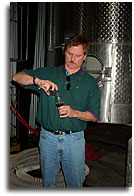 |
|
Rich
Richardson
|
Justin Vineyards is located out on the Westside, just off the road to Lake Nacimiento. Interestingly, they're only about 10 miles from the Pacific Ocean - though there's no easy way to get there. We arrived about 11:00 to meet with Rich Richardson, Justin's sales director. Rich was kind enough to show us around the vineyards as well as the new winery. Plus, he also mentioned something about tasting wine. Climbing into Rich's 4WD, we set off for a little vineyard tour on the "back 40." Circling around the back of the general offices and tasting room, Rich was taking us to the new winemaking facility - via the back door. During the drive, Rich described the vineyard layout. Justin has 72 acres planted, 38 in Cabernet. Most of Justin's production is Estate, although they make several non-Estate bottlings from purchased fruit.
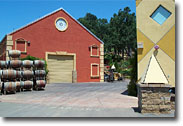 |
Begun in 2001, the new winemaking facility and caves were almost finished, and expected to be open to the public by early 2003. Cave-building is always a daunting undertaking for a winery - from both a logistical as well as a monetary standpoint. There are usually a great many variances needed to meet both city and county codes for building a cave, and the variance costs can be quite large. But, the finished product is going to be nice. The larger facility was needed both due to increased production, and current level of outsourced expense of storing barrels locally and case goods. We also had a chance to taste the new '01 Isosceles, which had been moved to tank for bottling. Very nice!
Arriving back at the tasting room, Rich turned us over to the staff and excused himself to get on with what must be a big job. At the tasting bar, we tasted through most of the current lineup, and Debbie Baldwin even dropped by to say hello. Another good visit.
|
Selected Tasting Notes: 1999 Norman Sauvignon Blanc - Paso Robles. Somewhat candied lemon-lime nose and mouthfeel - maybe a touch sweet on the palate as well. Well made, just has a little RS quality going for it. Aroma/Taste: B/B 1999 Norman Chardonnay - Paso Robles. Very tropical in nose and mouth, with medium body, and lightly chewy finish. Aroma/Taste: B/B 2001 Norman White Zinfandel - Paso Robles. Lots of lemonaid sweetness to this lightly berry-scented wine. Good balance, and long finish. Bet they sell a bunch of these. Aroma/Taste: B/B+ 1999 Norman Meritage - Paso Robles. Blend of Cab, Cab Franc, and Merlot, but the Cab Franc seems to dominate most of the aromas with its touch of green. Nice flavorful mouthfeel, with rich meaty flavors and a long finish. Aroma/Taste: B/B+ 1997 Norman Pinot Noir - Paso Robles. Slightly overripe black cherry nose, with an eerie Lawrys Seasoned Salt spicy aroma. Moderate-full body, good balance, ripe flavors, long finish. Aroma/Taste: B/B 1999 Norman Barbera - Paso Robles. Lightly smoky and charred nose, with a touch of sage or dill. Nice smoked meat flavor, very nice balance, long finsh. Aroma/Taste: B+/B+ 2000 Norman Zinfandel Classic - Paso Robles. Nose and flavors of boysenberry, cherry. strawberry, on a medium-bodied wine, with long balanced finish. More Primativo-like, and probably a good food match. Aroma/Taste: B+/B 2000 Norman Zinfandel Monster - Paso Robles. Somewhat riper and fuller than the Classic, the Monster shows more dark fruit, bigger body, and more chew. In other words: Turleyesque. Aroma/Taste: B/B+ |
Arrived at Norman Vineyards about 12:30. Another one of the "Far Out Wineries" (the self-named group of a dozen wineries that are located 'far out' to the West of Paso), Norman Vineyards has been farming the area since the early '70s. Finally, after more than two decades of growing grapes for others, the Art and Lei Norman decided it was time to start their own label, beginning in 1992. As winemaker for Norman, Robert Nadeau has created a legacy of very nice Cabs and Cab Francs. But, the Zin has been the attention-getter over the years. With names like "Classic" and "The Monster," Norman Zinfandels have established a reputation for consistency - no small feat in these times of vineyard challenges.
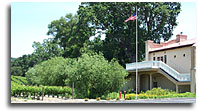 |
(Ever since my first visit in '94, I've always had a soft spot in my heart for this winery. On that occasion, with little provocation other than noticing our interest in wine, Art Norman not only offered us a taste of his experimental '84 Barbera, he also took our little group down to his cellar to taste a few wines. It was then that I recognized what gentleman he was, and marveled at his own fascination for wine. A wonderful visit.)
Though he apparently has no intention of relinquishing his duties at Norman, Robert Nadeau has gone on to start his own namesake label, which has been a great success. Meanwhile, Art and Lei have had some time to smell the roses - in addition to the grape must.
|
Selected Tasting Notes: 2001 Opolo Viognier - Paso Robles. Light peachy nose. Moderate mouthfeel, lightly crisp quality on the palate, medium-long finish. Aroma/Taste: B/B 2000 Opolo Pinot Noir - Paso Robles. Nose of candied bing cherry and cinnamon. Nice rich flavor, good balance, long finish. Aroma/Taste: B/B+ 2000 Opolo Zinfandel - Summit Creek, Paso Robles. Major blackberry and boysenberry aromas, with a nice sweet mouthfeel, very good balance, and slightly tart grip on the finish. Aroma/Taste: B+/B+ 2000 Opolo Zinfandel - Estate, Paso Robles. Big and jammy, good balance, long finish. 16.1% alcohol. Aroma/Taste: B/B 2000 Opolo Sangiovese - Estate, Paso Robles. Spicy black cherry nose and flavor, with a nice meaty chew on the palate, and long finish. No, it won't be mistaken for a Chianti - it's new world! Aroma/Taste: B+/B+ 2000 Opolo Merlot - Paso Robles. Fleshy and stemmy nose and mouth, classis Paso Merlot. Aroma/Taste: B/B+ 2000 Opolo Syrah - Paso Robles. Rich, sweet and tasty, with nice tarry licorice components, aqnd a long blackberry finish. 5th leaf. Aroma/Taste: B/B+ 2000 Opolo Cabernet Sauvignon - Paso Robles. Slightly green in aromas. Good mouthfeel and taste, although the fruit seems to fade off just a bit on the finish. Reminds me of a Dunning Cab. You'll never confuse it with something from Napa, but it seems to carry almost a Chinon quality to the fruit. Aroma/Taste: B/B+ 2000 Opolo Muscat Canelli - Paso Robles. Nose of pineapple upsidedown cake with floral elements. Clean and sweet; part quaffer, all tasty. Aroma/Taste: B/B ...from barrel... 2001 Opolo Syrah - Paso Robles. Slightly reduced nose, touch of sulphur and ink. Big and chewy mouthfeel, tasty through long finish. Aroma/Taste: B/B+ |
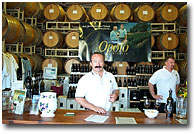 |
|
Rick
Quinn - Opolo Vineyards
|
Arrived about 11:55 at Opolo. First visit to this recently opened winery. Pouring out of their cellar/winery/storage room, there seemed to be a frenetic pace to the activity all around us. True, they were getting ready to exhibit their Viognier and Syrah at HdR, but there seemed to be something in the air. Quite a change from the serene surroundings of Norman, and probably just as well, considering the Bedlam we were expecting at the HdR tasting.
The name Opolo came from a wine indigenous to the Dalmatian Coast in the former Yugoslavia, and is a salute to Rick Quinn's heritage. The majority of vineyards have been producing fruit since 1998, and a small percentage of it has been finding its way into wine made by Quinn and Nichols ever since. Proprietors, Rick Quinn and Dave Nichols have a combined 280 acres of vineyards - about 200 acres on the Eastside and 80 acres on the Westside of Paso. The Westside vineyards in the Adelaide hills are planted to Pinot Noir and Sangiovese, while the Eastside locations are planted to Syrah and Cabernet Sauvignon.
Quinn had
usually sold the vast majority of his crop to other labels, such as Hess
Collection, St Supery, Harrison Vineyards, Wild Horse, Castoro Cellars,
and Fetzer. Recently, they decided to get into winemaking, building a
large facility that will also function as a custom crush winery. First
year's production, 1999, was 5,000 cases of Opolo wines, Merlot, Syrah,
Cabernet Sauvignon, Sangiovese, Zinfandel, and Muscat Canelli. The 2000
vintage will also include Chardonnay, Pinot Noir, and Cabernet Franc.
Most of the fruit will continue to be sold to those labels, but the estate
vineyards will be the only source of fruit for the Opolo label. Local
guru Robert Nadeau is a consulting winemaker to the operation.
Leaving Opolo, we headed directly to the Paso Robles fairgrounds, for the first tasting of the event, the older vintages. Great tasting (see HdR writeup). Out to dinner Alloro with several other folks.
Saturday, June 1, 2002
Up for a few morning visits before the next scheduled HdR tasting. This time out, we decided to try the Eastside of town.
|
Selected Tasting Notes: 2000 Chumeia Pinot Blanc - Monterey. Hints of lemon-lime in nose. Fleshy and slightly sweet lemony flavors. Aroma/Taste: B/B 2000 Chumeia Viognier - California. Nose of white peach and nectarine. Moderately think on the palate, good texture, long finish. Aroma/Taste: B/B 2000 Chumeia Chardonnay - Central Coast. Light petrol and swamp aromas to the otherwise tropical scents. Buttery mouthfeel, with toasty flavors, good balance, and moderate finish. Aroma/Taste: B/B 2000 Chumeia Pinot Noir - Edna Ranch, SLO. Nose of black cherry and cola, with touch of stem and mineral. Ripe cherry flavor, with a sweet spicy taste and long fruit-filled finish. Aroma/Taste: B+/B+ 2000 Chumeia Pinot Noir - Santa Lucia Highlands. Light smoky and stemmy aromas to the black cherry and strawberry fruit. Nice mouthfeel, very tasty fruit, good balance, long lovely finish. Aroma/Taste: B+/A- 2000 Chumeia Cabernet Sauvignon -85% Madera, 15% Paso Robles. Some steminess and a bit of green in the cassis and oak-scented nose. Soft, but tasty mouthfeel, good balance, medium-long finish. Aroma/Taste: B-/B 2000 Chumeia Zinfandel - Dusi & Lara's Vnyds, Paso Robles. Jammy nose of blackberry, blueberry, and boysenberry. Gutsy with full throttle mouthfeel that fades smoothly, cinching up with some oak at the finish. Aroma/Taste: B+/B+ 2000 Chumeia Syrah - Madera. Nose of blackberry, green bean, and grape stems. Stemmy tast on the palate, with good balance, and a fleshy grilled sausage taste. Aroma/Taste: B-/B 2000 Chumeia Silver Nectar - Paso Robles. Somewhat floral and spicy nose, with touch of apple and tropical aromas. Very fruity, nice ripe taste and texture, long finish. Blend ofChenin Blanc,Semillion, and Muscat. Aroma/Taste: B/B |
Arrived at Chumeia about 10:00. Pulling into the parking lot, we were surprised to see an empty bus sitting nearby. We were concerned this might mean that the winery was closed for a special event. But, the winery was indeed open - it just happened to be filled with occupants from the bus. Well, so much for our early, unencumbered visit.
Once inside the winery, we could see that there were indeed plenty of folks around - part of a busload of Eberle Wine Club members on their monthly tour. Luckily, Chumeia had opened a little early for accomodate them, and they were almost finished with their run of the place. So, it seemed all we had to do was wait it out. What to do while waiting? Funny you should ask. Since Mitch Tallan had graciously given us his "leftovers" from the Henschke's Hill of Grace tasting from the previous day's, we would have to make do. So, there we were, sipping some '96 and '01 Shiraz poured from individual water bottles, while waiting for the crowd to break up and move on. Tough work, this.
Relatively new to the area, Chumeia (the Greek word for alchemy) opened just last year. Founded by several ex-Meridian/J.Lohr alumni, the plan was to quickly establish vineyards and a winery, depending obviously on the talents of the former execs.
Using fruit from all over California, including Pinot Noir from Monterey and Edna Valley, Zinfandel, Cabernet, and Syrah from Paso, and Viognier from (are you ready) the San Joaquin Valley, they seem to have succeeded in establishing a presence. Interestingly, the San Joaquin Valley fruit comes from one of the partners' vineyards that they consider something special. Currently at 15,000 cases, Chumeia is generating a lot of traffic among the winery-touring crowd, as well as a few "serious" wines.
|
Selected Tasting Notes: 1999 DiCarlo Chardonnay - Paso Robles. Slightly oxidized, with hints of butter and oak dominating the tropical fruit. Tight mouthfeel, light pineapple flavor, moderate finish. Seems to be over the hill. Aroma/Taste: C/C+ 1999 DiCarlo Tempranillo - Paso Robles. Smoky black cherry and oak in the nose. Mostly astringent mouthfeel, oak-filled fruit, long slightly coarse finish. Aroma/Taste: C+/C+ 1998 DiCarlo Cabernet Franc - Paso Robles. Slightly oxidized nose of stems, dried flowers, and cassis. Dry mouthfeel, with vague fruity flavors, and woody finish. Aroma/Taste: C/C 1999 DiCarlo Zinfandel - Paso Robles. Sulphered or reduced nose of boysenberry and cedar. Light and slightly tart mouthfeel, long grippy finish. Aroma/Taste: C-/C 1998 DiCarlo Cabernet Sauvignon - Paso Robles. Light sweet cassis nose. Light-medium mouthfeel, decent fruit and flavors, moderate finish. Aroma/Taste: B-/C+ 1999 DiCarlo Cabernet Sauvignon - Paso Robles. Stemmy cassis and slight veggie hints in the nose. Light flavors and fruit, moderate mouthfeel. Aroma/Taste: C/C 1998 DiCarlo Petite Verdot - LeCuvier Vnyd, Paso Robles. Smoky cassis, with lots of chocolate, and some floral and blueberry notes. Tasty mouthfeel, if a bit monolithic. flavors of mocha, cassis, loganberry, and toast. Aroma/Taste: B/B |
 DiCarlo
Winery is located on a former 75-acre horse ranch on Highway 46 East and
Estrella Road. Sam DiCarlo is apparently now the sole proprietor of the
former BonZarlo winery.With a rural rustic appearance on the exterior,
the inside is a mixture of Tuscan Villa and El Rancho California. The
attractively decorated interior feels nice and "comfy," and
the staff was quite friendly. At the time of our visit, they were setting
up for a wedding, or wedding reception out back.
DiCarlo
Winery is located on a former 75-acre horse ranch on Highway 46 East and
Estrella Road. Sam DiCarlo is apparently now the sole proprietor of the
former BonZarlo winery.With a rural rustic appearance on the exterior,
the inside is a mixture of Tuscan Villa and El Rancho California. The
attractively decorated interior feels nice and "comfy," and
the staff was quite friendly. At the time of our visit, they were setting
up for a wedding, or wedding reception out back.
I recall being pleasantly surprised at the apparent quality of some of the wines tasted during the last year's visit here. Strangely, this year presented a somewhat different picture. On this visit, the winery was pouring some of the same vintage wines that were poured last year (the Chard, Cab Franc, and Cab Sauv). Overall, it appears the wines haven't held up during the intervening period. In addition, the '99 Tempranillo didn't hold a candle to the tastier '98 version. Maybe these bottles had stayed opened for a long period - I don't know. Either way, the results were less than stellar.
|
Selected Tasting Notes: 2001 Robert Hall Sauvignon Blanc - Paso Robles. Lots of pineapple, lemon-lime and light toast on the nose. Crisp mouthfeel, decent flavors, lightly toasty finish. Aroma/Taste: B/B 2001 Robert Hall Rouviere - Paso Robles. Dry and not particularly effusive nose. Light flavors on palate, dry and empty mouthfeel. Kitchen-sink blend from available fruit. Aroma/Taste: B-/C+ 2000 Robert Hall Chardonnay - Paso Robles. Smoky and toasty nose. Light, crisp and refreshin, moderately fruity, but not very Chard-like. Aroma/Taste: B/B- 2000 Robert Hall Merlot - Paso Robles. Very ripe nose, mostly Cab-like cassis. Slightly sweet and cloying on the palate, fruity finish. 18% Cab.Aroma/Taste: B-/B- 2000 Robert Hall Cabernet Sauvignon - Paso Robles. Nose of cassis, raisin, and prune. Stemmy backbone on the palate, with a tasty if soft mouthfeel, medium-long finish. Aroma/Taste: B-/B 2000 Robert Hall Syrah - Paso Robles. A little more of a blend in it's profile, the nose has stemmy blackberry and floral scents. Lighter mouthfeel and flavors, with a narrow focus, and medium-long finish. 15% Cab. Aroma/Taste: B/B 1999 Robert Hall Syrah Reserve - Paso Robles. Sweet, lightly spiced blackberry nose. Fleshy mouthfeel, with black cherry and a touch of chocolate, and a soft toasty finish. Aroma/Taste: B+/B+ 2000 Robert Hall Zinfandel - Paso Robles. Nose of boysenberry and oak. Flavorful mouthfeel, good balance and finish. Aroma/Taste: B/B 2001 Robert Hall Syrah - Paso Robles. Slightly reduced and flinty, with stemmy blackberry aromas. Sweet and thicker mouthfeel than the previous vintage. Nice flavors, good fruit, interesting tar and licorice components. Aroma/Taste: B/B |
Located on East Hwy 46, this new operation is striving to leave a impression. On the 300 acres purchased in 1995, Hall planted extensive vineyards and built an immense cellar/barrel storage facility. Respected local vintner and grower Howie Steinbeck consulted on some of aspects of the operation. Now up to 300 acres of fruit as of 2001, Hall has hired former Texas winemaker Don Brady as winemaker.
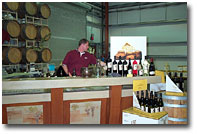 |
Current production is 7,000 cases, but plans are to produce 30,000 cases annually. It would seem the intent here may be offer custom crush facilities to supplement the relatively small house brand, because the 25,000 sq.ft. winemaking and warehouse space above ground, and 19,000 sq.ft. of barrel room storage below ground - is enough for 4,000 barrels. Yes, you could call this a cave, but it's actually more of a cavern.
The current tasting room is located inside the production facility. But, a future Hospitality Center will be located nearby. There are several good vineyards out on the East side, so this may be a place to watch. Time will tell. Current offerings were average, but certainly nothing special - possibly owing to its reliance on new vineyards. Or, maybe it's just the style profile they staking out. Were led on a short tour of the facility by April Cole, who covered lots of stats, and did a very nice job of pointing out some of the winery's state-of-the-art equipment, along with its gravity flow system which emphasizes non-intervention in the winemaking process.
|
Selected Tasting Notes: 2000 Rainbow's End Merlot - $16. Fruity and spicy nose, good fleshy mouthfeel, long finish. Aroma/Taste: B/B 2000 Rainbow's End Cabernet Sauvignon - $14. Claret style Cab, with lighter flavors and concentration, good balance, medium-long finish. Aroma/Taste: B/B 2000 Rainbow's End Syrah - San Marcos Ck Vnyd. $16. Light mouthfeel, fruity and ripe, not particularly syrah-like. Aroma/Taste: B/B 2000 Rainbow's End Zinfandel - $14. Syrah-like nose, with a spicy and peppery Zin-like mouthfeel. Aroma/Taste: B/B 2000 Rainbow's End Late Harvest Zinfandel - $18. nicor mouthfeel. Aroma/Taste: B/B |
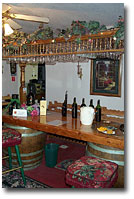 |
Arrived at Rainbow's End Winery. Jim and Shirley Gibbons initially bought the 35-acre property in 1980, then decide to plant vineyards in 1990, and bonded as a winery in 1999. They sell most of 35 acres planted (22 acres of Cabernet Sauvignon), but are producing 15,000 cases under their own label. With just over 25 acres of fruit, Rainbow's End is pSroducing Merlot, Cabernet Sauvignon, Zinfandel, Late Harvest Zinfandel, Chardonnay, Nebbiolo, Syrah, and White Zinfandel, they seem to have all the bases covered.
The name 'Rainbows End,' came from a photograph that a neighbor had taken of the property just after a rainstorm, with a rainbow arcing through the sky and ending at the vineyard.
|
Selected Tasting Notes: 1999 Pretty Smith Sauvignon Blanc - Paso Robles. $13. Slightly medicinal nose. Toasty and grassy flavors, long finish. Aroma/Taste: B-/B 1999 Pretty Smith Chardonnay - Paso Robles. $16. Lemon-lime and tropical nose. Good chewy mouthfeel, tasty long finish. Aroma/Taste: B/B+ 1999 Pretty Smith Merlot - Paso Robles. $18. A bit odd and musty in the nose. Nice mouthfeel, fleshy and tasty fruit, long finish. Aroma/Taste: B-/B+ 1999 Pretty Smith Cabernet Franc - Paso Robles. $18. Lightly herbaceous and floral nose. Sweet mouthfeel, very tasty fruit, nice long finish. Aroma/Taste: B/B+ 1999 Pretty Smith Cabernet Sauvignon - Paso Robles. $18. Nose seems a little off - mostly overripe and slightly green. Tasty mouthfeel. 10% Sangiovese. Aroma/Taste: B/B 1999 Pretty Smith Zinfandel Port - Paso Robles. $28. Somewhat woody, but sweet and tasty, with a nice chewy finish. Aroma/Taste: B/B+ |
Arrived Pretty Smith about 2:30 to an empty room. Off the beaten path in San Miguel, North of Paso, I've mostly been aware of this winery by its previous name, Mission View Estate. The winery overlooks the old Mission San Miguel, close to where the first mission first planted vines in the 1700’s.
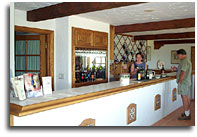 |
Purchased by Lisa Pretty and Victor Smith in September of 2000, Mission View Estate, included 45acres of Chardonnay, Zinfandel, Cabernet Sauvignon, Sauvignon Blanc, Merlot, Cabernet Franc, and Syrah, along with the winery and the inventory. After the purchase, the duo began to upgrade the vineyard and winery with the hopes of lauching an upper-scale Pretty-Smith label. They succeeded with the 2001 release of a '99 Fumé Blanc, Chardonnay, Cabernet Sauvignon, Cabernet Franc and Merlot.
|
|
|
All rights reserved No original material may be reproduced without written consent Mail & Comments - Eric Anderson |
||

|
||
